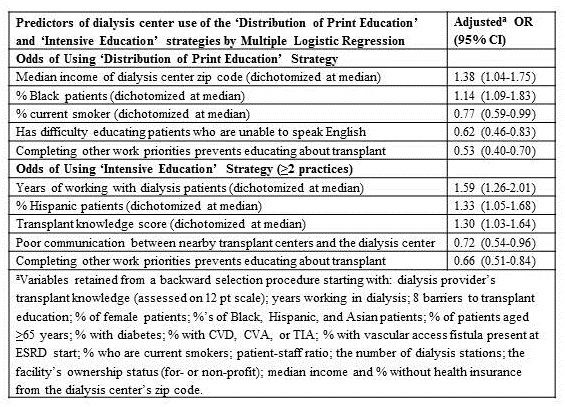Educational Strategies for Increased Wait-Listing Rates: Opportunities for Dialysis Center Intervention.
A. Waterman,1 J. Peipert,1 H. Xiao,2 C. Goalby,1 K. Lentine.2
1UCLA, Los Angeles, CA
2SLU, St. Louis, MO
Meeting: 2017 American Transplant Congress
Abstract number: 93
Keywords: Kidney transplantation, Patient education, Psychosocial, Waiting lists
Session Information
Session Name: Concurrent Session: Psychosocial and Mediation Adherence Concerns
Session Type: Concurrent Session
Date: Sunday, April 30, 2017
Session Time: 2:30pm-4:00pm
 Presentation Time: 3:18pm-3:30pm
Presentation Time: 3:18pm-3:30pm
Location: E271b
Dialysis centers vary in how well they educate patients about kidney transplant (KT). This study categorized common groups of educational strategies used by dialysis staff; assessed whether these strategies were associated with increased KT wait-listing rates; and determined predictors of using optimal strategies. We surveyed representatives in a national sample of 1694 U.S. dialysis centers (2011-2015) about their use of the 12 KT education practices and 8 barriers to providing KT education. Using principal components analyses (loading range: 0.47-0.90), we reduced the 12 practices to 4 strategies: 1) Oral Transplant Recommendations (recommendations to learn more, be evaluated, and referrals to external organizations), used by 52% of centers; 2) Patient Discussions (discussions about the risks/benefits of KT), used by 31%; 3) Distribution of Print Education (brochures, websites, or KT center phone numbers), used by 17%; and 4) Intensive Education (showing KT videos, giving KT information in the center lobby, providing education for potential living donors, and opportunities to talk with prior recipients), where 3% used all 4 practices. Wait-listing events within 1 year of the survey for patients at each center were identified from linked United States Renal Data System records. After adjusting for center characteristics, Distribution of Print Education [incident rate ratio (IRR) = 1.19, 95% CI: 1.04-1.36] and Intensive Education (IRR = 1.11, 95% CI: 1.04-1.36) were associated with increased dialysis center wait-listing rates. Predictors of dialysis center use of the Distribution of Print Education and Intensive Education strategies included multiple barriers to providing education and higher transplant knowledge among dialysis staff. (Table) The strategies associated with increased wait-listing rates, Distribution of Print Education and Intensive Education, are less common. Modifiable barriers to their use include insufficient knowledge of KT by providers, insufficient time to educate about KT, and lack of communication between dialysis and transplant centers, pointing to possible areas for future intervention and study.
CITATION INFORMATION: Waterman A, Peipert J, Xiao H, Goalby C, Lentine K. Educational Strategies for Increased Wait-Listing Rates: Opportunities for Dialysis Center Intervention. Am J Transplant. 2017;17 (suppl 3).
To cite this abstract in AMA style:
Waterman A, Peipert J, Xiao H, Goalby C, Lentine K. Educational Strategies for Increased Wait-Listing Rates: Opportunities for Dialysis Center Intervention. [abstract]. Am J Transplant. 2017; 17 (suppl 3). https://atcmeetingabstracts.com/abstract/educational-strategies-for-increased-wait-listing-rates-opportunities-for-dialysis-center-intervention/. Accessed January 6, 2026.« Back to 2017 American Transplant Congress
